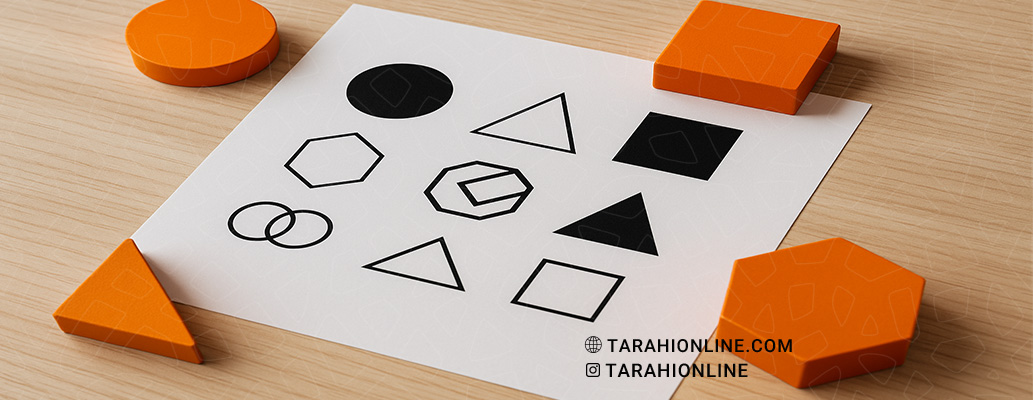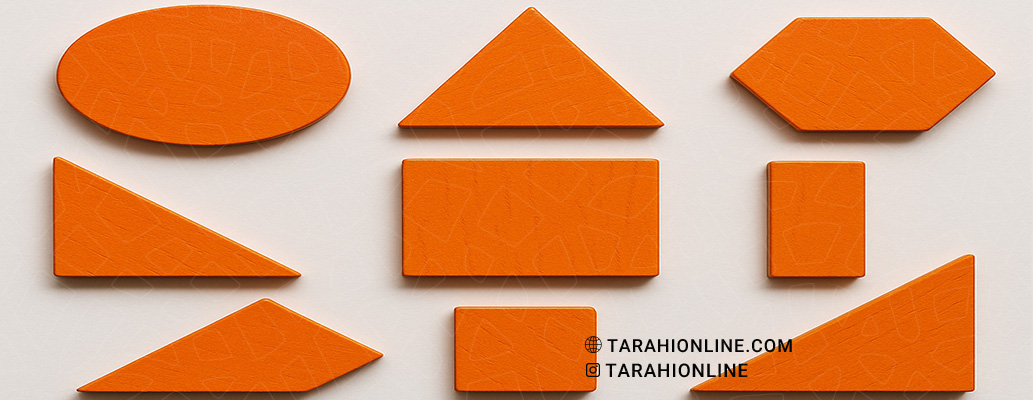
Logo design is one of the most critical aspects of a brand’s visual identity. Logos must not only be aesthetically pleasing and memorable but also convey the brand’s messages and values subconsciously to the audience. One of the key tools in logo design is the use of geometric shapes. Due to their simplicity, clarity, and visual strength, geometric shapes play a significant role in creating emotional and conceptual connections with audiences. In this article, we explore the meanings and concepts of various geometric shapes in logo design and their psychological impacts.

The Importance of Geometric Shapes in Logo Design
Geometric shapes, with their structured and recognizable forms, are easily imprinted in the audience’s mind. From a visual psychology perspective, these shapes evoke specific emotions and perceptions that can align with a brand’s goals and values. The use of geometric shapes in logo design is significant for the following reasons:
- Simplicity and Clarity: Geometric shapes are simple and easily adaptable across various sizes and media.
- Universality: These shapes carry similar meanings across different cultures, making them easily understandable.
- Flexibility: Geometric shapes can be used independently or in combination, adapting to various design styles.
- Psychological Impact: Each geometric shape conveys specific emotions and concepts to the audience.
Below, we examine the main geometric shapes and their meanings in logo design.
Geometric Shapes and Their Meanings
- Circle
- Concepts: Harmony, completeness, unity, eternity, community, friendliness
- Description: With no beginning or end, circles symbolize infinity and perfection. They evoke feelings of calmness, softness, and friendliness, often used by brands aiming to convey warmth and connection.
- Applications:
- Tech brands like AT&T and NASA use circles to signify innovation and universality.
- In healthcare or charity brands, circles convey care and support.
- Example: Starbucks’ logo, with its central circle, evokes a sense of invitation and warmth.
- Square
- Concepts: Stability, balance, trust, professionalism, strength
- Description: With equal sides and right angles, squares symbolize order and solidity. They are ideal for brands aiming to convey reliability and strength.
- Applications:
- Financial and insurance companies like American Express use squares to evoke security and trust.
- Tech brands like Microsoft use squares to signify professionalism and structure.
- Note: Overuse of squares may convey rigidity, so they should be used thoughtfully.
- Rectangle
- Concepts: Order, progress, professionalism, longevity
- Description: Similar to squares but with differing side lengths, rectangles convey dynamism and movement. They are often used by brands aiming to project growth and development.
- Applications:
- Media brands like BBC use rectangles to convey structure and credibility.
- In construction and architecture, rectangles suggest strength and progress.
- Triangle
- Concepts: Power, dynamism, direction, change, creativity
- Description: With sharp angles and a dynamic structure, triangles convey movement and energy. The orientation (upward, downward, or sideways) alters the meaning—upward triangles symbolize growth, while downward ones may suggest stability or caution.
- Applications:
- Sports brands like Adidas use triangles to convey energy and motion.
- Tech companies like Google Play use triangles to signify innovation and forward direction.
- Lines
- Concepts: Movement, connection, direction, simplicity
- Description: Lines, whether horizontal, vertical, or diagonal, carry varied meanings. Horizontal lines suggest calmness and stability, vertical lines convey strength and progress, and diagonal lines evoke dynamism and energy.
- Applications:
- Nike’s iconic Swoosh, a curved line, conveys motion and speed.
- Minimalist logos like IBM’s use lines to reinforce simplicity and professionalism.
- Polygons
- Concepts: Complexity, innovation, diversity
- Description: Polygons with more than four sides (e.g., hexagons or octagons) convey complexity and creativity. They are ideal for innovative and modern brands.
- Applications:
- Tech companies like Intel use polygons to signify advancement and innovation.
- In creative industries, polygons can represent diversity and creativity.
Psychology of Color and Geometric Shapes
In addition to shapes, colors play a vital role in amplifying a logo’s message. Combining geometric shapes with appropriate colors can significantly enhance a logo’s visual and emotional impact. For example:
- Red with a triangle: Amplifies energy and passion.
- Blue with a circle: Evokes trust and calmness.
- Green with a square: Conveys stability and connection to nature.
Key Considerations for Using Geometric Shapes in Logo Design
- Alignment with Brand Identity: The chosen shape must align with the brand’s values and message. For instance, a luxury brand may use circles for perfection, while a sports brand may use triangles for dynamism.
- Simplicity in Design: Simple logos with clear geometric shapes are more memorable.
- Balance and Harmony: Overusing a single shape or combining shapes improperly can make a logo appear unbalanced.
- Versatility: Logos must remain legible and appealing across various sizes and media, from business cards to billboards.
Successful Examples of Geometric Shapes in Logos
- Apple: The bitten apple logo, with its curved, circle-like form, conveys simplicity, innovation, and friendliness.
- Pepsi: Its circular logo with vibrant colors evokes youth and energy.
- BMW: The combination of circles and blue-and-white colors conveys quality and trust.
Geometric shapes are powerful tools in logo design for conveying visual and emotional messages. From circles symbolizing harmony to triangles representing dynamism, each shape can profoundly impact how audiences perceive a brand. Logo designers must understand the psychological and cultural implications of these shapes and use them in alignment with the brand’s identity and values. By thoughtfully combining geometric shapes, colors, and design styles, a logo can be created that is not only beautiful and memorable but also effectively communicates the brand’s message to its audience.
The Tarahi Online graphic and logo design team, with over ten years of experience in professional graphic and logo design, is ready to assist you and bring your ideas to life. Contact us to submit your request or place an order.
